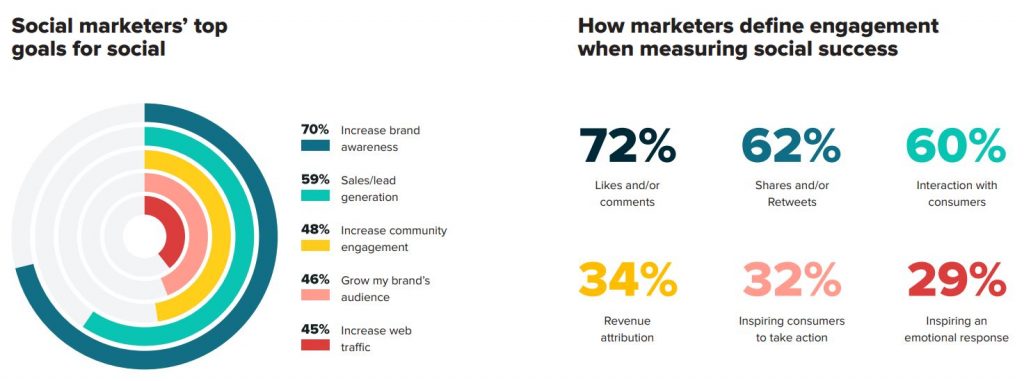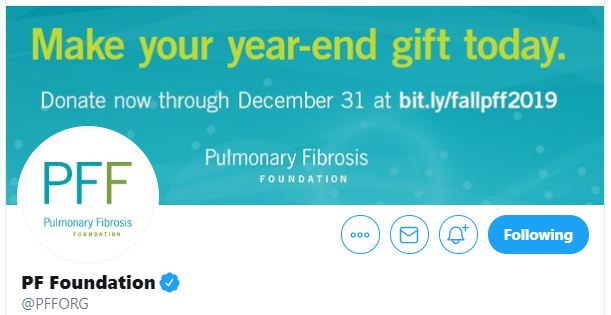Whether you run a small clinic or a nationally recognized hospital, if you work for a medical organization, you’re in the business of saving lives. Social media is an excellent (and relatively inexpensive!) tool to share the important work your medical organization is doing with those who are already connected to your organization and potential supporters. Almost half the world’s population is on social media. Sixty-nine percent of adult Americans use at least one social network and spend, on average, two and a half hours on their social networks per day. If you’re looking to promote an event, raise money, inform community members about the services your medical organization provides, and more, then social media’s the tool to make it happen!
Keep reading for five steps to build a social media strategy for your medical organization!
1. Identify Your Audience
Identifying your target audience is a necessary step for any communication plan. Identifying your target audience will help you determine what platforms your organization should be active on. It’s possible that your medical organization has multiple audiences. For example, your clinic might provide care to individuals 65 and older, but your annual 5k fundraiser is attended by individuals aged 25 to 50. In this case you’ll want to ask yourself the following: Who attends our events? Who uses our services? Who are our supporters? And finally, what platforms are they on? If you’re looking to reach an untapped audience and diversify your current client or donor base, then look at platforms outside of what may be used by your current members
Different demographics (age groups, genders, etc.) flock to different social media platforms. Therefore, the platforms your patients and supporters are most likely on are the platforms you want to invest time in.
Facebook is the most popular social media platform and is a staple for most organizations. This is because 68% of adult social media users are on Facebook. 74% of female social media users use Facebook while 62% of male social media users use Facebook. 51% of social media users between 13 and 17 years of age are on Facebook. As are 81% of 18 to 29-year-olds, 78% of 30 to 49-year-olds, 65% of 50 to 64-year-olds, and 41% of social media users over 65.
Instagram has one billion active monthly users and 400 million active daily users. If you have the time to invest in capturing videos and images (that don’t violate patient confidentiality) Instagram is a great platform to take advantage of. 39% of female social media users use Instagram while 30% of male social media users use Instagram. 72% of social media users between the ages of 13-17, 64% of 18 to 29 year-olds, 40% of 30 to 49 year-olds, 21% of 50 to 64 year-olds, and 10% of social media users over 65 use Instagram.
24% of female social media users use Twitter while 23% of male social media users use Twitter. Geared towards a younger audience, 40% of social media users ages 18 to 29, 32% of users ages 13 to 17, 27% of 30 to 49 year-olds, 19% of 50 to 64 year-olds, and 8% of social media users over 65 use Twitter.
LinkedIn is primarily used for B2B marketing and connecting professionals. Therefore, if your medical organization has several important business partners on LinkedIn and is regularly hiring, LinkedIn would be a great platform to adopt. LinkedIn has over 660 million registered users. Comparing the genders of LinkedIn users found users evenly split with 25% of female and 25% of male social media users using the site. In addition, 29% of social media users aged 18 to 29, 33% of 30 to 49 year-olds, 24% of 50 to 64 year-olds, and 9% of social media users over 65 use LinkedIn.
2. Create Clear Goals for Your Social Media Presence
According to the Sprout Social Index report, the top three goals marketers have for the social media channels they manage are to increase brand/organization awareness, generate leads/sales (to your organization this could mean increase patient numbers), and increase engagement. These three broad goals should guide your post content and overall social media strategy.

When you create social media goals for your medical organization try to make them concise and measurable. Who is your goal targeting? When do you want to reach your goal by? Follow the EGAD acronym outlined in Managing Public Relations by Peter Smudde: Effect, Goal, Audience, Deadline. View the examples below to see EGAD in action!
- Increase awareness of our hospital by gaining 100 new Facebook page likes from Tampa Facebook users by April 1, 2020.
- Increase our Twitter engagement rate by 3% by posting visual content and polls by January 1st.
- Inform more people about our medical services by increasing the number of clicks to our “services” landing page from social by 5% by January 1st.
If this is your medical organization’s first time to sit down and talk about goals for social media, then feel free to start broad and then narrow your focus. Read more about goal setting for social media here.
3. Use Platforms That Cater to Your Audience and Your Organization Has Time to Manage
Each social media platform has its own expectations and posting “norms.” Posting regularly is an expectation that comes with social media. If you don’t post regularly your followers won’t know what to expect. Therefore, posting infrequently makes the value of following or liking your organization’s page unclear.
Try and post daily on Facebook and LinkedIn. Because tweets are much shorter than other social media posts, the best practice for Twitter is to post at least three times per day (this can include retweets of other users’ content). Post at least once per day on Instagram, even if you’re just posting to your story. If your organization is only able to post on Twitter once per week, for example, try sticking to Facebook and posting daily on that platform until you have the bandwidth to expand to other platforms.
In addition to evaluating what you have the time to manage, look at your patients’ and supporters’ demographics to determine what social media platforms you should manage. If your organization primarily serves retirees, for example, investing your time and resources into Facebook instead of Twitter is a good choice. However, if you have a booming youth/pediatric program Twitter and Instagram would be great platforms to invest time in.
4. Create Posts That Meet Your Goals and are Tailored to Your Platform
What are your medical organization’s social media goals? Every post you create should achieve a strategic goal. Having clear goals will help legitimize social media as a communication tool to your board members and managers and result in quality content that provides a clear value to your followers.
Your posts can be informative (informing your followers of a new women’s health course, announcing a partnership with a nationally recognized hospital, announcing a clinic expansion, etc., for example); and your posts can focus on motivating your audience to take an action (like asking for participants for a 5k fundraiser and providing a link to a signup form, posting about your newsletter with the goal of driving traffic to your newsletter signup form, etc.). Whether you’re trying to fundraise or increase awareness of your medical organization’s services, all your posts will fall into one of these two goals—informing your audience or persuading your audience to take action.
After you’ve drafted a post ask yourself the following questions. What value does this bring to our followers? Is it informing them of something, or is it persuading them to take action? When you craft posts aimed at inspiring action make sure your call to action (CTA) is clear and you provide an avenue for your followers to act. This can be a link to a class sign up form or the phone number of your organization. The last thing you want is a post promoting a health class with no clear way for your followers to sign up!

Once you’ve set a goal for your post make sure it meets best practices for each platform.
Social media post best practices
Facebook – Always strive for concise copy! Posts should be no longer than 470 characters. The sweet spot ranges from 200-300 characters. Images uploaded with posts should be 1,200 by 630 pixels. Hashtags aren’t used to follow trending topics like they are on Twitter and LinkedIn, so only use hashtags if you’ve branded a series with a hashtag (#WomensHealthMonth or #ThrowbackThursday for example).
Twitter – Only 280 characters are allowed in a tweet. An image uploaded in a post (shared image) should be 1024 x 512 pixels. Hashtags and emojis are encouraged! Use hashtags to help your posts be found by twitter users that may be interested in your content.
LinkedIn – Posts should be no longer than 500 characters. The sweet spot is around 300 characters. An image uploaded in a post (shared image) should be 1104 x 736 pixels. Use hashtags to help users find your content.
Instagram – Copy should be under 300 characters. Photo thumbnails are 161 x 161 pixels, but images should be uploaded as 1080 x1080 pixels. Rectangular images can be uploaded to Instagram as well, but in the thumbnail view the edges of the photo will be cut off. Use hashtags and emojis in your post description.
5. Brand Your Content
Determining the visuals and messaging you’ll use to represent your medical organization ensures that you have a clear framework to build posts and graphics in. This design and messaging framework make up your organization’s brand. Branding done well can add legitimacy to your social media accounts, increase engagement on your posts, and even result in more traffic to your website. To clearly brand your content you should have the following:
Logos sized for social media
On each platform you manage you should have your organization’s logo as your profile picture so your account can be easily found by those who are interested in learning more about your organization. This helps solidify your brand identity and is a step in making your medical organization visually recognizable. You can incorporate your logo and mission statement on your cover photo for added brand recognition.
On Facebook a business page profile picture is 180 x 180 pixels and a cover photo is 820 x 312 pixels. On Twitter a profile picture is 400 x 400 pixels and the header photo is 1,500 x 500 pixels. On LinkedIn a business page logo is 300 x 300 pixels and the cover photo is 1536 x 768 pixels. For Instagram your profile image should be 110 x 110 pixels. Sizing your profile and cover photos for each platform is necessary to ensure your photos aren’t blurry or cut-off. Use sites like Canva or editing software like Photoshop or Lightroom to resize your images.
A color scheme that represents your organization
Look at your website, pamphlets, and brochures. Any common colors that stand out can be incorporated into your social posts to carry your organization’s brand onto your content. Canva and Adobe Spark are great tools for creating social media graphics—you can even create a color pallet to use in all of your posts which creates a branded look.

Fonts
An important part of creating and maintaining a brand is choosing a font to represent your medical organization. Most organizations have a principle font and two or three sub-fonts. Fonts can vary extremely, so creating visual consistency by limiting the number of different fonts used from one to three in your designs is important.
Conclusion
Social media is an excellent tool for your medical organization to share its mission and communicate with supporters. With these six tips you can begin to create a social media strategy that engages your community and increases awareness of your important work.
For more insight on creating a great social media strategy for your medical organization, check out these blogs:







